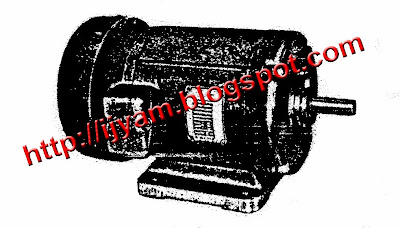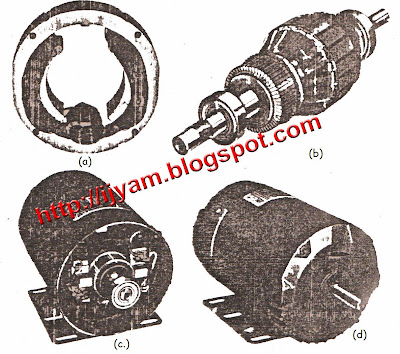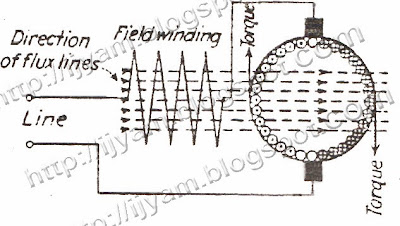- - Smooth acceleration, retardation, or deceleration.
- - A carefully controlled rate of acceleration or retardation.
- - Controlled speed changes, over small or wide ranges.
- - Accurate and positive speed matching.
- - Control or limit of the torque or tension.
 |
| Figure 1: Direct Current (DC) Motor |
Parts of a DC Motor:
- Field Structure - necessary to provide a magnetic circuit for the flux and to hold the field coils. It consists of a yoke, pole bodies, pole faces and sometimes interpole to assist commutation.
- Field Coils - may consist of : a) shunt coils wound with many turns of small wire, connected in series with each other and across the line or in parallel with the armature. b.) series coils with fewer turns and larger wire, which are connected in series with the armature line. c.) both shunt and series coils for a compound motor. d.) interpole.
- Armature - the rotating element, consisting of slotted punchings pressed onto the shaft. These punchings perform the dual purpose of providing a path for the magnetic flux and of carrying the armature winding.
- Commutator and Brushes - the commutator consists of a large number of copper segments which are insulated from each other and from the armature shaft. These copper segments are connected to the armature windings. The commutator and brushes combination is necessary to feed the current to the armature.
- Commutating Poles (Interpoles) - occasionally used in fractional horsepower DC motors to improve commutation. These are small auxiliary poles placed halfway between the main poles and connected in series with the armature. There maybe as many interpoles as main poles, or only as half.
 |
Figure 2: Parts of a DC Motor. (a) field Structure (b) armature
(c) front end showing commutator, brushes and brush riggings (d) complete motor
|
Principle of operation
All DC motors are supplied from a source of steady DC voltage, such as from a battery, or from a generator that has a very low ripple current. A simple DC motor is represented schematically in figure 3 shown below.
Armature windings, together with commutator and brushes, are so arranged that the flow of current is in one direction in all of the conductors on one side of the armature and in the opposite direction in all of the conductors on the opposite side of the armature. This condition is represented in the figure above by the use of dots to indicate current flowing toward the observer, and by plus signs to indicate current flowing away from the observer.
The field winding sets up a magnetic field as shown in the figure. It is a simple fundamental law of motor action that, if current passed through a conductor which is perpendicular to a magnetic field, a mechanical force will be exerted on the conductor, mutually perpendicular to both the conductor and the direction of the field.
A rule for the direction of this force is given in the left-hand rule which will give an upward force on all conductors to the left, and a downward force on all conductors to the right, so that a torque is developed in a clockwise direction.



No comments :
Post a Comment
Leave a comment!
Add your comment below: